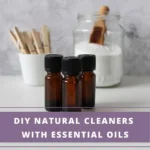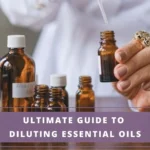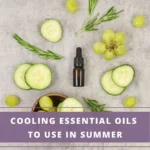As an Amazon Associate I earn from qualifying purchases. See Full Disclosure Here
Knowing how to use an essential oil diffuser correctly is key to enjoying the benefits of aromatherapy.

Let me start by saying this – using the device itself is easy.
All brands provide illustrated step-by-step instructions so you can’t really go wrong regardless of the type of diffuser you buy.
However, there’s more to using a diffuser than just the basic how-to instructions.
It’s important to dig a little deeper into how to use your essential oil diffuser the right way. This will help you get the maximum benefits of the oil you add to your device while avoiding any mishaps.
Here’s what you’ll find in this article to help you get the most from your aromatherapy journey:
How essential oil diffusers work
Types of aroma diffusers and how to choose the right one for you
How to use your essential oil diffuser: step by step
How many drops of essential oil to add to your diffuser
Choosing the right essential oils for your diffuser
How to clean your diffuser
Safety considerations
Troubleshooting common problems
How Do Essential Oil Diffusers Work?
These devices are designed to release essential oils into the air to provide therapeutic benefits.
There are a few different types of diffusers for essential oils. Each type works using a different mechanism.
In general, these devices work by dispersing minute volatile components of essential oils into the air. Some models do this using heat or steam, while others use super-fast vibrations.
These microscopic droplets spread around the area, infusing it with the aroma of the essential oil that’s in the reservoir.
In addition to the amazing aroma, diffusing essential oils also allows you to enjoy a range of therapeutic benefits, depending on the type of oil used.
Types Of Diffusers For Essential Oils And How To Choose The Right One
This is just a short recap of the different types of aromatherapy diffusers available. You’ll find a more detailed explanation here ‘Types of Diffusers for Essential Oils and the Pros & Cons of Each’
Ultrasonic – These are the most popular types of essential oil diffusers and offer the best value for money. They use high-frequency vibrations to break down essential oils into tiny particles, which are then dispersed into the air as a fine mist. They do double duty as mini humidifiers and are especially beneficial in winter. Because no heat is used, the properties of the essential oil remain intact so you get its full therapeutic benefits.
Nebulizing – The most powerful type of aromatherapy diffuser, these devices have an inbuilt atomizer that vaporizes essential oils and releases ultra-fine particles into the air. No heat or water is used to diffuse the oil, so you get the concentrated aroma and full therapeutic properties of the oil. If you have the budget for it, definitely buy a nebulizing diffuser.
Passive – Essential oil jewelry and reed diffusers are two types of passive diffusers. They use natural diffusion to evaporate essential oils, dispersing the aroma into the air. Although not the most effective to use indoors, aromatherapy jewelry allows you to get the benefits of essential oils when you’re out of the home.
Heat – Heat diffusers work using either an electric power source or a flame such as a candle to generate heat. These are the cheapest but also the least effective type of device. Heat damages the beneficial properties of essential oils so you don’t get any of the benefits. Buy a heat diffuser only if you are on an extremely tight budget.
If you don’t have a diffuser, be sure to read this Guide To Buying A Diffuser For Essential Oils.
How To Use An Ultrasonic Or Nebulizing Diffuser: Step-By-Step
To use an ultrasonic or nebulizing diffuser:
Step 1- Remove the top cover from the base.
Step 2- Add water into the base container up to the max line indicated. Do not overfill. Skip this step for nebulizing diffusers as they do not use any water.
Step 3- Add essential oil – scroll below to see how many drops to use.
Step 4- Replace the top cover.
Step 5 – Adjust the mode, light, and mist settings on your diffuser. This will differ from one model to another. The settings are usually user-friendly but when in doubt refer to your manual.
Step 6 – Turn your diffuser on and enjoy the wonderful aroma.
You should start to get the scent of the essential oil used within a few minutes.
How Many Drops of Essential Oil to Put In A Diffuser

Most units require only a few drops of oil. The exact number of drops will depend on the size and design of the diffuse.
Typically, 3-5 drops of oil are sufficient for a smaller model, while larger models may require more.
Fortunately, you don’t have to guess how many drops of essential oil to put in your diffuser. Refer to the manufacturer’s instructions for recommended ratio of oil and water.
Don’t stray too far from the recommended quantities. Adding extra drops won’t give you extra benefits and adding too few drops is ineffective.
As a general rule, it’s better to take it slow when you’re just starting. Use fewer drops than recommended and use the device for shorter periods of time at first. Too much too soon can overwhelm your senses. You may also experience headaches and nausea.
Remember, you can always add a few more drops of essential oil if the scent is too faint but you can’t remove the excess oil if it’s too strong.
Essential oils are concentrated. One drop can make a significant difference. If you want to increase the concentration, always do this one drop at a time.
How Much Water To Add In The Reservoir
This only applies to ultrasonic diffusers. You don’t add water to a nebulizing diffuser.
The amount of water to be put in the base reservoir depends on the size of the device.
Every device will have a maximum line marked inside the tank. Add water only up to the maximum fill line. Do not overfill or the unit may not run properly.
Larger capacity devices can hold more water and run for a longer period of time. But, you will also need to add more essential oil drops so the aroma is not too diluted.
Adding too few drops of essential oil in a larger quantity of water is ineffective. You won’t enjoy either the aroma or the therapeutic benefits.
Choosing the Right Essential Oils To Diffuse
When choosing essential oils to diffuse it’s important to consider the aroma and the potential benefits of each oil.
Some popular options include:
Lavender: Known for its calming and relaxing properties, lavender is a popular choice for use in the bedroom or for promoting relaxation.
Peppermint: With its refreshing and invigorating aroma, peppermint is a great choice for use in the office or for promoting mental clarity and focus.
Eucalyptus: Eucalyptus is a powerful respiratory oil that can help to improve breathing and support overall respiratory health.
Rose: The reigning aphrodisiac essential oil, rose is great for ramping up the mood in the bedroom.
Where To Place The Unit
Where you place the unit is important to avoid any mishaps.
Place the device on a steady surface so it doesn’t topple over and spill the contents.
Choose a low coffee table as the mist with essential oils rises upwards. Placing it at a lower level allows you to get the full aroma and therapeutic benefits.
Of course, if you have kids or pets, you’ll want to place the device on a high enough surface so it’s out of their reach.
Don’t place the unit in the direct path of a fan. This will redirect the vapors and scatter the essential oil molecules away from you.
Avoid placing the device next to an open window or in a sunny spot. The open window will allow the vapors to escape outside and exposure to direct sunlight destroys the properties of essential oils.
How to Clean Your Diffuser

Essential oils can be corrosive and will damage the mechanism if left in the tank for extended periods. Make it a habit to never leave water or oils in the reservoir for days at a time without use.
Cleaning the unit regularly will help to prevent mineral buildup that could damage the device and shorten its life span.
To keep your device functioning properly and prevent buildup, it’s important to clean it regularly.
Here’s how to clean your essential oil diffuser:
– Unplug the device.
– Empty any remaining water and oil from the tank after each use if you use it only occasionally. Leaving water in the reservoir for extended periods encourages mold and bacterial growth. It may also corrode the mechanism.
– If you use the device regularly, empty the water at least once a week or whenever you’re using a different essential oil.
– Wipe down inside and outside the unit with a soft clean cloth.
– Use a small amount of vinegar or rubbing alcohol to clean the tank and diffuser, rinsing thoroughly with water afterward.
– Dip a clean cotton swab in white vinegar or rubbing alcohol and gently wipe the ultrasonic chip to remove possible mineral buildup
– Be sure to follow the manufacturer’s instructions for cleaning your specific model.
– Wipe the surface with a damp cloth and a little soap if necessary.
Safety Considerations When Using An Essential Oil Diffuser
While aroma diffusers are generally safe to use, there are a few important safety tips to keep in mind:
Use only high-quality, pure essential oils in your device.
Don’t leave the device unattended while it is operating. Switch it off if you need to go out or be away for a long time.
Keep the device out of reach of children and pets.
Diffusing essential oils is the easiest and most convenient way to get the benefits of essential oils.
Learning how to use, where to place, how many drops to use in your diffuser, and other safety considerations will help you get the maximum benefits without the risks.
Troubleshooting Common Problems with Essential Oil Diffusers
If you experience any issues with your appliance, there are a few common problems and solutions to try:
Not working: Check to make sure the power cord is properly plugged in and the water level is at or above the fill line.
Weak aroma: Try using a different essential oil or adding more drops to the water. One drop can make a big difference. Make sure to add one drop at a time.
Making too much noise: Check to make sure the water level is above the minimum line marked on the inside and the unitis placed on a flat surface.
FAQs On How To Use An Essential Oil Diffuser
Are aroma diffusers safe to use?
Yes, aromatherapy diffusers are safe to use provided that you use your device according to the manufacturer’s instructions. If you have two different types of diffusers, follow the different guidelines for each.
Do I need to empty out the water after each use?
Not necessarily. If you’re using your device regularly, it’s okay to empty out the water after a couple of uses. However, do not let the water sit in the tank for too long as this can damage the system.
Can I mix different essential oils in the reservoir?
Yes, you can mix different essential oils to create your own unique blend. Be sure to follow the recommended dilution ratios for each individual oil and adjust the number of drops accordingly.
Can I use tap water in the tank?
It’s best to use filtered or distilled water in the water tank to avoid any mineral buildup or potential damage to the unit.
Can I use fragrance oils in the reservoir?
Technically yes, but it’s not advisable. Fragrance oils are not the same as essential oils. Unlike essential oils, which are 100% natural, fragrance oils contain a large percentage of synthetic chemicals. Inhaling these vapors can be toxic.
How long should I run the unit?
Every model has its own timer settings. These typically range from 1-3 hours. Others run continuously until the water runs out, at which time the auto-shutoff kicks in and shuts the device down. Follow the manufacturer’s instructions for the specific model you’re using.
Can I use my diffuser in any size room?
It’s best to use a diffuser for large rooms if you want to diffuse essential oils in a large space. A small unit may not be as effective in a large space. You can use any type of diffusion device for smaller rooms including a reed diffuser or a passive diffuser.
Related Reads:
Top-Rated Ultrasonic Diffusers
Car Essential Oil Diffusers: The Ultimate Guide
List Of Essential Oils & Their Uses: A Reference Guide
Prefer to use reed diffusers? How to Use A Reed Diffuser
Don’t want to buy an aroma diffuser? 25 Ways To Use Essential Oils Without A Diffuser
Disclaimer: This information is not intended to serve as medical advice. Please consult your doctor before using any natural medication or if you experience any unusual symptoms. See Full Disclaimer here.









